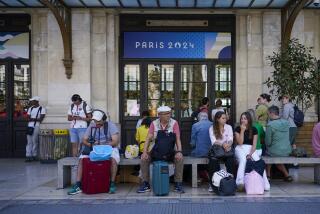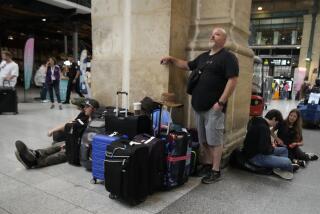‘Chunnel’ Blaze’s Smoke Fades, but Not Questions
- Share via
LONDON — For nine hours, firefighters from two countries battled their worst nightmare--a stubborn blaze under the English Channel in the new rail tunnel linking Europe with Britain. When it was over Tuesday morning, there were melted rails, burned wires, severe damage in the “Chunnel” and embarrassing questions on both sides of the water.
Choking from smoke and fumes, 31 truck drivers and three crew members escaped from a Britain-bound freight train that burst into flames Monday night about 10 miles from Calais, a third of the way through the 31-mile tunnel.
Three inquiries in Britain and France were launched Tuesday to find out what happened and why in what was the worst incident since the Chunnel opened two years ago.
By Tuesday night, all of the eight passengers and crew members who had to be hospitalized were on their way home. But the tunnel was closed amid chaotic traffic on both sides of the channel that was compounded by gales and snow.
Some limited Chunnel service may resume today, but officials said it will be months before full operations are again possible.
There was praise for the rescue operation and for firefighters who braved searing heat and choking darkness. But the incident raised new questions about the trouble-plagued Chunnel. As travelers jostled for space on airplanes and ferries, Eurotunnel shares slumped Tuesday in London trading.
“A few more minutes and it would have been a catastrophe,” said truck driver John Williams.
Le Shuttle--as the French term the Chunnel express--has carried almost 1 million trucks without serious incident, and there was no sign of trouble Monday night when the train left Calais carrying 29 trucks, most of them 44-ton 18-wheelers and each in its own lattice-sided rail car.
Because the cars are open-sided, truck drivers make the 20-minute journey through the tunnel in a special lounge car--unlike motorists, who remain with their vehicles in enclosed rail cars designed to withstand fire for at least 30 minutes. Inflammable and hazardous cargoes are banned in the tunnel.
Monday’s blaze apparently began near the rear of the train in a truck carrying polystyrene, a plastic-like packing material. Fanned by the speed of the train, it quickly spread to five other trucks. In all, 15 trucks and the rear locomotive would be damaged before the fire was quelled.
Smoke enveloped the train without warning, filling the lounge car with a noxious vapor that choked the truck drivers. The train came to a halt. Truckers told British reporters that they then lay on the floor with wet napkins on their faces for 20 minutes.
At that point, the crew evacuated passengers into a service tunnel that runs parallel to the two main rail tunnels. A France-bound passenger train picked up the injured; the eight suffering from smoke inhalation were hospitalized overnight in France.
“If the disaster plan really worked well, people would have been evacuated without being exposed to noxious smoke. I’d hate to think of this happening to a trainload of tourists,” said Colin Brown of Britain’s Consumers’ Assn.
Critics on both sides of the channel immediately raised questions that probably will be echoed by company and government investigators. With emergency fire bays installed at either end of the tunnel, why did the train stop? How did the smoke get into the closed lounge car so quickly?
And: Why were large tunnel exhaust fans designed to pull smoke away from any burning train not effective? Why did it take an hour for the tunnel operator to alert fire crews in Britain?
Criticism focused on the rail cars, which were built with an open framework to minimize their weight. “The cars are the weakest link in the tunnel design,” said Nigel Harrisk, editor of Rail Magazine.
More to Read
Sign up for Essential California
The most important California stories and recommendations in your inbox every morning.
You may occasionally receive promotional content from the Los Angeles Times.












